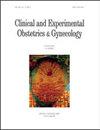Abdominal Radical Hysterectomy as an Alternative Treatment Option for Patients with Cervical Cancer without Access to Radiotherapy Facilities
IF 0.6
4区 医学
Q4 OBSTETRICS & GYNECOLOGY
引用次数: 0
Abstract
Background: To compare the oncological outcomes of Chinese patients with International Federation of Gynecology and Obstetrics (FIGO) 2018 stage IIIC cervical cancer (CC) receiving radical chemoradiotherapy (R-CT), abdominal radical hysterectomy (ARH), or neoadjuvant chemotherapy and radical surgery (NACT). Methods: Overall, 4086 patients in 47 hospitals from 2004 to 2018 were divided into groups according to stage (4029 with stage IIIC1 and 57 with stage IIIC2). Kaplan-Meier and Cox regression analyses were applied to compare the 5-year overall survival (OS) and disease-free survival (DFS) of the three initial treatments before and after propensity score matching (PSM). Results: The 5-year DFS was worse in patients with stage IIIC2 than in those with stage IIIC1 (post-PSM: 68.3% vs. 39.9%, p < 0.001). For stage IIIC1, the ARH group had better 5-year OS (post-PSM: 71.0% vs. 80.0%, p < 0.001) and DFS (post-PSM: 67.2% vs. 71.0%, p < 0.001) than the R-CT group, while the NACT group had worse 5-year DFS (post-PSM: 67.7% vs. 55.3%, p = 0.002). The 5-year OS (post-PSM: 80.9% vs. 70.5%, p < 0.001) and DFS (post-PSM: 70.7% vs. 54.1%, p < 0.001) were better in the ARH than in the NACT group. For stage IIIC2, the 5-year DFS was better in the ARH than in the NACT group (45.4% vs. 30.1%, p = 0.025). Conclusions: The oncological prognosis of patients with stage IIIC1 CC was generally better than that of patients with stage IIIC2, thereby supporting the rationale behind the classification of stage IIIC. In less developed areas, the ARH is a promising alternative treatment option for patients with stage IIIC; nonetheless, the use of NACT is not advisable. Clinical Trial Registration: The study was registered at http://apps.who.int/trialsearch/, registration number CHiCTR1800017778.腹部根治性子宫切除术作为无法获得放射治疗设施的宫颈癌患者的替代治疗选择
背景:比较国际妇产科学联合会(FIGO) 2018年IIIC期宫颈癌(CC)患者接受根治性放化疗(R-CT)、腹部根治性子宫切除术(ARH)或新辅助化疗加根治性手术(NACT)的肿瘤预后。方法:2004 - 2018年47家医院4086例患者按分期分为组(IIIC1期4029例,IIIC2期57例)。采用Kaplan-Meier和Cox回归分析比较三种初始治疗前后的5年总生存期(OS)和无病生存期(DFS)。结果:IIIC2期患者的5年DFS较IIIC1期患者差(psm后:68.3% vs. 39.9%, p <0.001)。对于IIIC1期,ARH组有更好的5年OS (psm后:71.0% vs 80.0%, p <0.001)和DFS (psm后:67.2% vs. 71.0%, p <0.001),而NACT组的5年DFS较R-CT组差(psm后:67.7%比55.3%,p = 0.002)。5年OS (psm后):80.9% vs. 70.5%, p <0.001)和DFS (psm后:70.7% vs. 54.1%, p <0.001), ARH组优于NACT组。对于IIIC2期,ARH组的5年DFS优于NACT组(45.4% vs. 30.1%, p = 0.025)。结论:IIIC1期CC患者的肿瘤预后普遍好于IIIC2期,支持IIIC分期的理论基础。在欠发达地区,ARH是IIIC患者的一种有希望的替代治疗方案;然而,使用NACT是不可取的。临床试验注册:本研究注册于http://apps.who.int/trialsearch/,注册号CHiCTR1800017778。
本文章由计算机程序翻译,如有差异,请以英文原文为准。
求助全文
约1分钟内获得全文
求助全文
来源期刊
CiteScore
0.50
自引率
0.00%
发文量
241
审稿时长
1 months
期刊介绍:
CEOG is an international, peer-reviewed, open access journal. CEOG covers all aspects of Obstetrics and Gynecology, including obstetrics, prenatal diagnosis, maternal-fetal medicine, perinatology, general gynecology, gynecologic oncology, uro-gynecology, reproductive medicine, infertility, reproductive endocrinology, sexual medicine. All submissions of cutting-edge advances of medical research in the area of women''s health worldwide are encouraged.

 求助内容:
求助内容: 应助结果提醒方式:
应助结果提醒方式:


